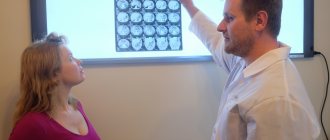Confusion is a pathological condition expressed in impaired ability to navigate in time and space, failures in short-term memory and decreased attention. It is caused by a disorder of brain activity and can be a sign of both somatic and mental illnesses. Stupefaction is sometimes a consequence of acute intoxication (drug, alcohol, drugs), dehydration, hypothermia or heat stroke, severe physical fatigue, shock as a result of stress.
Stunned or lethargic
When faced with dazedness or inhibition, patients react poorly to their environment and speech, and they become indifferent to everything they see, hear and feel. If the disease worsens, simple stupor can turn into a coma
, that is, a complete “turn off” of consciousness. After exiting this state, the patient will remember absolutely nothing about what happened. The patient may fall into a coma if he has diabetes, kidney or liver failure, as well as some other diseases.
Treatment
Since confusion is only a syndrome of general pathological conditions of the body, treatment is aimed at relieving the underlying disease. In case of acute intoxication, measures are taken aimed at removing toxic substances from the body and maintaining breathing and cardiac activity.
For cerebrovascular accidents associated with trauma or stroke, surgery may be indicated. Prescribed drugs that improve blood circulation in the brain tissue.
Treatment of encephalitis is based on antiviral therapy and prevention of cerebral edema with corticosteroids and diuretics.
For epilepsy, maintenance therapy with anticonvulsants is carried out to prevent seizures. In Alzheimer's disease, drug therapy for cognitive impairment is possible, but the disease is incurable.
If confusion is caused by post-traumatic shock or mental disorders, drugs are prescribed that help stabilize the patient’s psycho-emotional state - antidepressants, antipsychotics and tranquilizers.
The reception is conducted by specialists
Tagirov Akram Karamovich
neurologist, reflexologist
Delirium (hallucinations)
This syndrome means that the patient may experience various kinds of hallucinations - deceptions of the senses and perception. For example, a person may hear voices that are not there or see something that does not exist. At the same time, the patient is completely confident that everything is happening for real, and cannot distinguish reality from illusion. In this regard, the patient may experience severe behavioral deviations. They can manifest themselves in both positive and negative emotions, depending on the nature of the hallucinations.
For this reason, the patient can be dangerous both to himself and to others and society in the broad sense of the word. When “returning to reality,” the memory of hallucinations is preserved, but the memory of reality is most often not. This symptom often manifests itself in severe poisoning and infectious diseases.
Etiology and pathogenesis
The etiological factors of delirium are varied; more often, even post-stroke delirium is caused by a combination of different causes. It is often caused by the pathophysiological consequences of acute somatic diseases (including stroke), their complications and side effects of drugs. The development of delirium is often caused by a combination of non-modifiable factors (pre-existing dementia or serious medical illness) and additional, often modifiable factors (use of sedatives, infections, etc.). The etiology of postoperative delirium is the most studied [2]. In the population of very old people, the main risk factor is dementia. Studies have shown that both delirium and dementia are associated with reduced cerebral blood flow [27, 28], acetylcholine deficiency [29], and inflammatory processes [30]. This commonality of pathogenetic mechanisms largely explains the close relationship between these disorders.
The study of risk factors for the development of delirium [2, 31-34] made it possible to identify potentially modifiable and non-modifiable ones.
To potentially modifiable
Risk factors include: decreased functioning of sensory systems (deafness or blindness); immobilization (catheter or bandages); taking medications (hypnotics, narcotics, anticholinergic substances, corticosteroids), polypharmacy, withdrawal of alcohol or other drugs; acute neurological disorder (ischemic stroke, intracranial hematoma, meningitis, encephalitis); intercurrent diseases (infections, iatrogenic complications, acute somatic illness, anemia, dehydration, malnutrition, fracture, trauma, HIV infection); metabolic disorders; surgical intervention; environmental change (transfer to intensive care unit); pain; emotional stress; long-term sleep deprivation.
To non-modifiable factors
Risks of delirium include: dementia; age over 65 years; a history of delirium, stroke, neurological disease, or a fall or gait disorder; many comorbid diseases; being male; chronic renal or liver failure; apolipoprotein E genotype.
The pathogenesis of delirium has not been sufficiently studied, including because this condition can be caused by various pathogenetic mechanisms.
It is currently believed that the development of delirium may be due to the side effects of drugs and an acute stress reaction, which can cause changes in neurotransmission. The most common cause of delirium is considered to be a dysfunction of the cholinergic system [29], and this is justified by a number of factors [35-41]. There is also mention [42] of dysfunction of the dopaminergic system, as well as an imbalance of the dopamine and cholinergic systems. The most important support for this hypothesis is the positive effect of antipsychotics on the course of delirium [43]. In addition, there are suggestions of an imbalance in the glutamatergic, GABAergic, serotonergic and norepinephrine systems.
The pathogenesis of delirium is considered in terms of immune disorders. According to the neuroimmune hypothesis, ischemia, trauma or other brain damage causes increased production of pro-inflammatory cytokines, which significantly affect the synthesis and release of acetylcholine, dopamine, serotonin, norepinephrine [44], and may also have a direct neurotoxic effect [45].
A number of studies [46–48] have found that the level of proinflammatory cytokines is significantly increased in delirium.
The acute stress response hypothesis suggests that increased production of ACTH and cortisol plays a role in the development of delirium, which in turn affects the state of neurotransmitter systems and immunomodulation. This hypothesis has been confirmed in a number of works [49-52].
An important direction in the study of the pathogenesis of delirium is neuroimaging studies [27, 28, 53], which showed the presence of hypoperfusion in various regions of the brain - the frontal and occipital lobes, the thalamus, the basal ganglia and occipital lobes, as well as in the anterior cingulate gyrus. These studies also found that changes in perfusion in different regions are not constant.
Considering pathogenetic factors, it should be noted that several mechanisms may be involved in the development of delirium. Thus, when studying markers of delirium in the cerebrospinal fluid [54], changes in the level of metabolites of serotonin, interleukin-8, cortisol, lactate and total protein levels were found. In addition, there was an increase in the levels of acetylcholinesterase, dopamine metabolites, somatostatin, β-endorphin and neuron-specific enolase.
Oneiric state (“waking dream”)
This symptom is associated with an influx of vivid hallucinations, most often with fabulous, impossible and even absurd content. The patient sees all these images and pictures, but, unlike delirium
, maintains the position of an external observer and does not actively participate in the “action”.
At the same time, the patient’s orientation in space and understanding of his own personality are disrupted. The memory of illusions is partially preserved. This symptom often occurs with congenital heart disease and certain types of infections.
Amentive clouding of consciousness (amentia)
This is a condition in which the patient completely loses all ability to navigate both in space and in himself and his experiences. Everything he sees and feels is perceived in fragments and is not something whole. The processes of thinking and understanding what is happening are disrupted. of delirium occur
and
oneiric state
, causing fear.
The speech of such people can be thoughtless and incoherent. They are also characterized by a sharp change in activity, that is, excitement can suddenly give way to apathy
and helplessness. My mood also changes unusually often.
The amental state can be quite long - up to several months, and it is sometimes replaced by short periods of “enlightenment”. The dynamics of the disease completely depend on the physical condition of the patient, and this condition itself is characteristic of sepsis and cancer intoxication. In general, the very fact of an amental state, as a rule, indicates a serious illness in the patient.
Twilight stupefaction
Twilight stupefaction is considered one of the most specific symptoms in medicine in general. It is characterized by complete loss of memory for the period of morning and evening (twilight). The patient's ability to navigate in space is severely impaired, severe hallucinations are possible, which the patient is afraid of, as well as incoherent speech and muttering. Fortunately, this symptom is quite rare and is not accompanied by a complete loss of consciousness (unlike, for example, epilepsy).
A characteristic feature of mental confusion in somatic diseases is that some of the memories are erased. The darknesses themselves are short-lived and proceed dynamically, often moving from one to another and to a normal state.
Glossary of terms
In this section we have collected all the terms that you might encounter in this article. Gradually, we will collect from these explanations a real dictionary of a narcologist-psychiatrist. If some concepts remain unclear to you, leave your comments under the articles on our site. We will definitely help you figure it out.
Amentive clouding of consciousness (amentia)
– a form of clouding of consciousness, characterized by the patient’s confusion, incoherence of his speech and thinking, and disorder of movements. With amentia, complete clarity of consciousness does not occur at all, communication with the patient becomes impossible.
Hallucination
– images arising in the patient’s mind without external conditions. As a rule, hallucinations appear with the use of psychoactive substances (alcohol, drugs, many psychotropic medications), significant fatigue, as well as with mental disorders and neuralgia. Regular and prolonged hallucinations are a common occurrence in schizophrenia and are significant complications of its clinical picture.
Delirium
– a type of mental disorder associated with impaired consciousness (at first, clouding syndromes appear, then up to coma).
Accompanied by true hallucinations
(mainly visual), illusions, delusions,
senestopathies
and other symptoms. After recovering from delirium, the patient may forget both real events and hallucinations. A patient with delirium can be dangerous to himself and others.
True hallucinations
– a type of hallucination in which an imaginary object is located in objective space. They differ from illusions in that they do not occur in people who do not have mental disorders.
Comatose state (coma)
- a borderline state between life and death that threatens life. It is characterized by the patient’s loss of consciousness, lack of reactions to external stimuli or a significant decrease in such reactions, loss of reflexes, disturbances in breathing and pulse, and temperature regulation.
Oneiric state (oneiroid, schizophrenic delirium)
– mental pathology associated with a qualitative disturbance of consciousness (the so-called “oneiric disorientation”. The patient sees detailed pictures, experiences pseudo-hallucinatory sensations that are confused with reality. The patient is lost in time and space, may be confused in his own personality. Many include people around them in their fictional situation One of the characteristic signs of oneiroid is considered to be the transformation of the human “I” - for example, when a person begins to consider himself a tree or a bird.
Schizophrenic delirium
– the same as
oneiric state (oneiroid)
.
Reasons for providing assistance
Article 29 of the “Law on Psychiatric Care and Guarantees of the Rights of Citizens in its Provision” cites immediate danger to oneself or others as the first criterion for providing involuntary psychiatric care. However, you should pay attention to the fact that for this the mental disorder must be severe.
If you are dealing with someone who has behavioral problems, it is best to seek mental health advice to ensure your safety (and theirs).
All materials on the site are presented for informational purposes only, approved by certified physician Mikhail Vasiliev, diploma series 064834, in accordance with license No. LO-77-005297 dated September 17, 2012, by a certified specialist in the field of psychiatry, certificate number 0177241425770.









